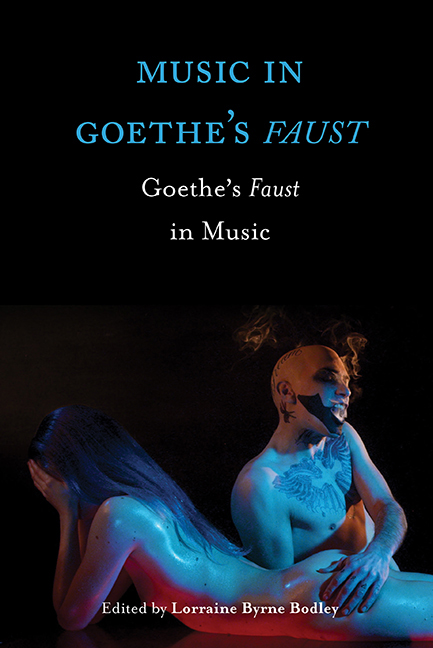Book contents
- Frontmatter
- Dedication
- Contents
- List of Illustrations
- Contributors
- Acknowledgements
- Abbreviations Used in the Notes
- Introduction. Rhapsody and Rebuke: Goethe's Faust in Music
- Part I Goethe's Faust: Content and Context
- Part II Legacies: Goethe's Faust in the Nineteenth Century
- 6 Faust's Schubert: Schubert's Faust
- 7 The Musical Novel as Master-genre: Schumann's Szenen aus Goethes Faust
- 8 The Psychology of Schumann's Faust: Developing the Human Soul
- 9 A Life with Goethe: Wagner's Engagement with Faust in Music and in Words
- 10 Wagner's Ninth: Reading Beethoven with Faust
- 11 Linking Christian and Faustian Utopias: Mahler's Setting of the Schlußszene in his Eighth Symphony
- Part III Topographies: Stagings and Critical Reception
- Part IV New Directions: Recent Productions and Appropriations
- Select Bibliography
- Index
11 - Linking Christian and Faustian Utopias: Mahler's Setting of the Schlußszene in his Eighth Symphony
from Part II - Legacies: Goethe's Faust in the Nineteenth Century
Published online by Cambridge University Press: 30 August 2017
- Frontmatter
- Dedication
- Contents
- List of Illustrations
- Contributors
- Acknowledgements
- Abbreviations Used in the Notes
- Introduction. Rhapsody and Rebuke: Goethe's Faust in Music
- Part I Goethe's Faust: Content and Context
- Part II Legacies: Goethe's Faust in the Nineteenth Century
- 6 Faust's Schubert: Schubert's Faust
- 7 The Musical Novel as Master-genre: Schumann's Szenen aus Goethes Faust
- 8 The Psychology of Schumann's Faust: Developing the Human Soul
- 9 A Life with Goethe: Wagner's Engagement with Faust in Music and in Words
- 10 Wagner's Ninth: Reading Beethoven with Faust
- 11 Linking Christian and Faustian Utopias: Mahler's Setting of the Schlußszene in his Eighth Symphony
- Part III Topographies: Stagings and Critical Reception
- Part IV New Directions: Recent Productions and Appropriations
- Select Bibliography
- Index
Summary
Upon its publication, Goethe's Faust II met with perplexing reception as to its generic classification and complex narrative. Writers who boldly proposed an allegorical interpretation also reflected on its resistance to traditional stage presentation. Robert Schumann, who set to music scenes from both Parts I and II of Faust, made Faust the protagonist of his oratorio Szenen aus Goethes Faust (1844–53). Franz Liszt's setting of the ‘Chorus mysticus’ at the end of his Faust- Symphonie (1854) represented an unconventional response to Goethe's text. But it was not until Gustav Mahler's Eighth Symphony (1906) that the Schlußszene from Faust II received an admittedly monumental treatment. By setting to music the parts of Faust II that were rarely set to music, Mahler made redemption – with all its interpretative baggage – the epicentre and eventual apogee of his work.
Mahler set the First Part of the Eighth Symphony to the Latin Pentecost hymn Veni creator spiritus (‘Come Holy Ghost, Creator’), while the Second Part comprises an exalted melopoiesis of the final scene of Part II of Goethe's Faust. The setting of the sacred hymn Veni creator spiritus abounds in secular musical references (band music and marches, with subtle allusions to sacred music), whereas Goethe's secular text is clothed in music of unmistakably religious character. The protagonist's struggle and the drama's mystical message of redemption seem to have resonated with the composer, as revealed in the genesis of the work and subsequent interpretations gleaned from his correspondence. Like Goethe's Faust, the Eighth traverses the genre's boundaries, and its musical ethos defies generic expectations. By sculpting the text in the mould of a symphony, Mahler upholds – and simultaneously critiques – the prevailing tradition of the venerable symphonic genre. At the same time, the Eighth reinforces perceptions of universality and authority appropriate to a setting of Faust, while it also offers a musical analogue to its ambivalent and multivalent status as a genre.
- Type
- Chapter
- Information
- Music in Goethe's FaustGoethe's Faust in Music, pp. 183 - 198Publisher: Boydell & BrewerPrint publication year: 2017

